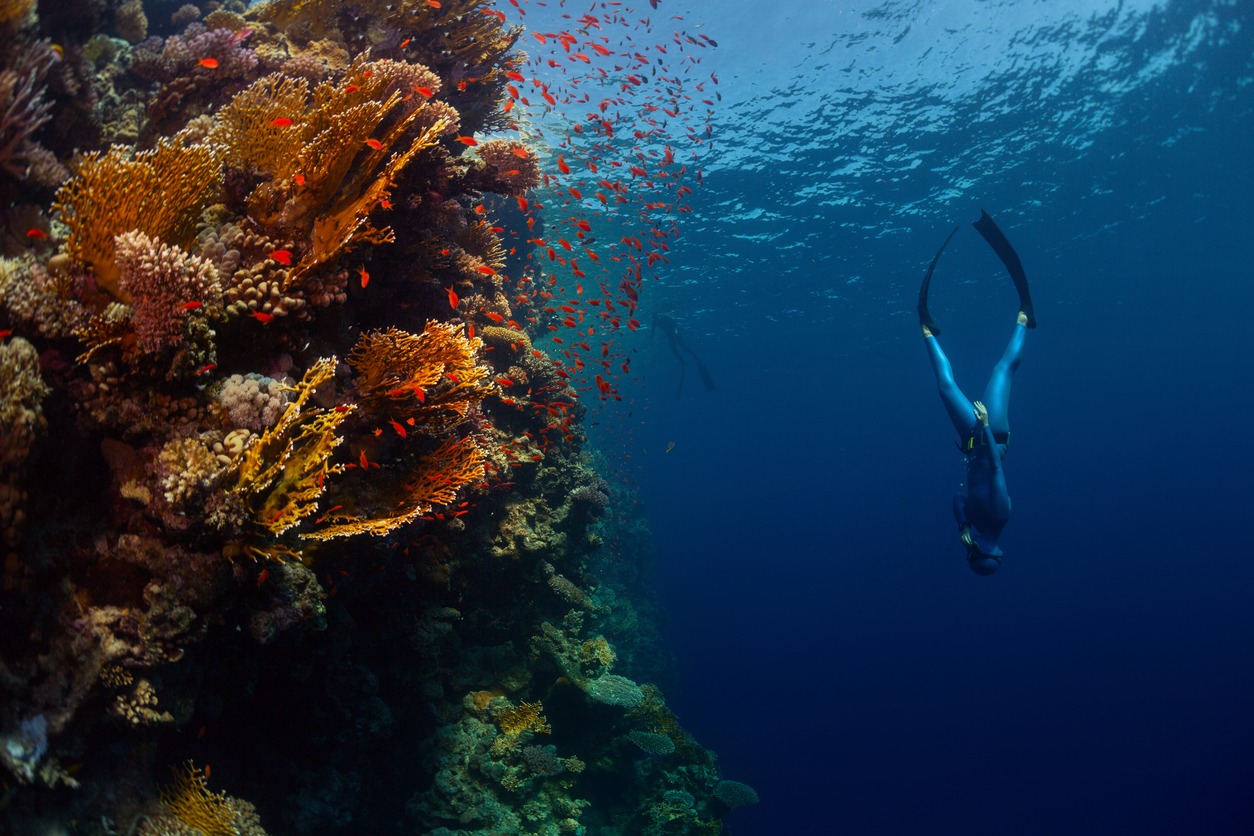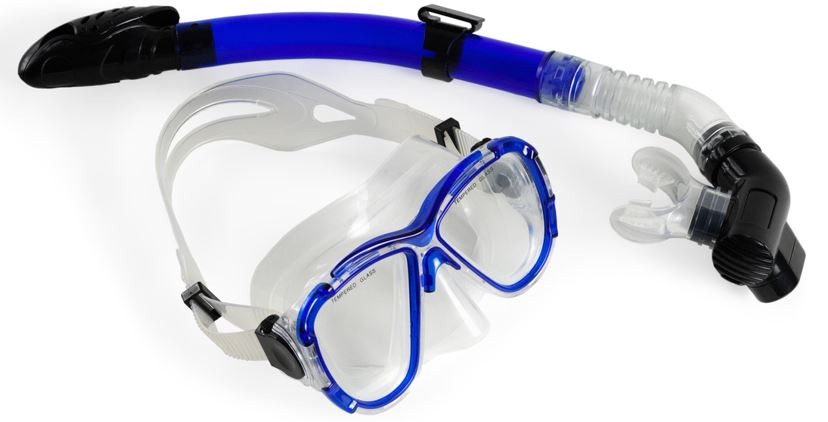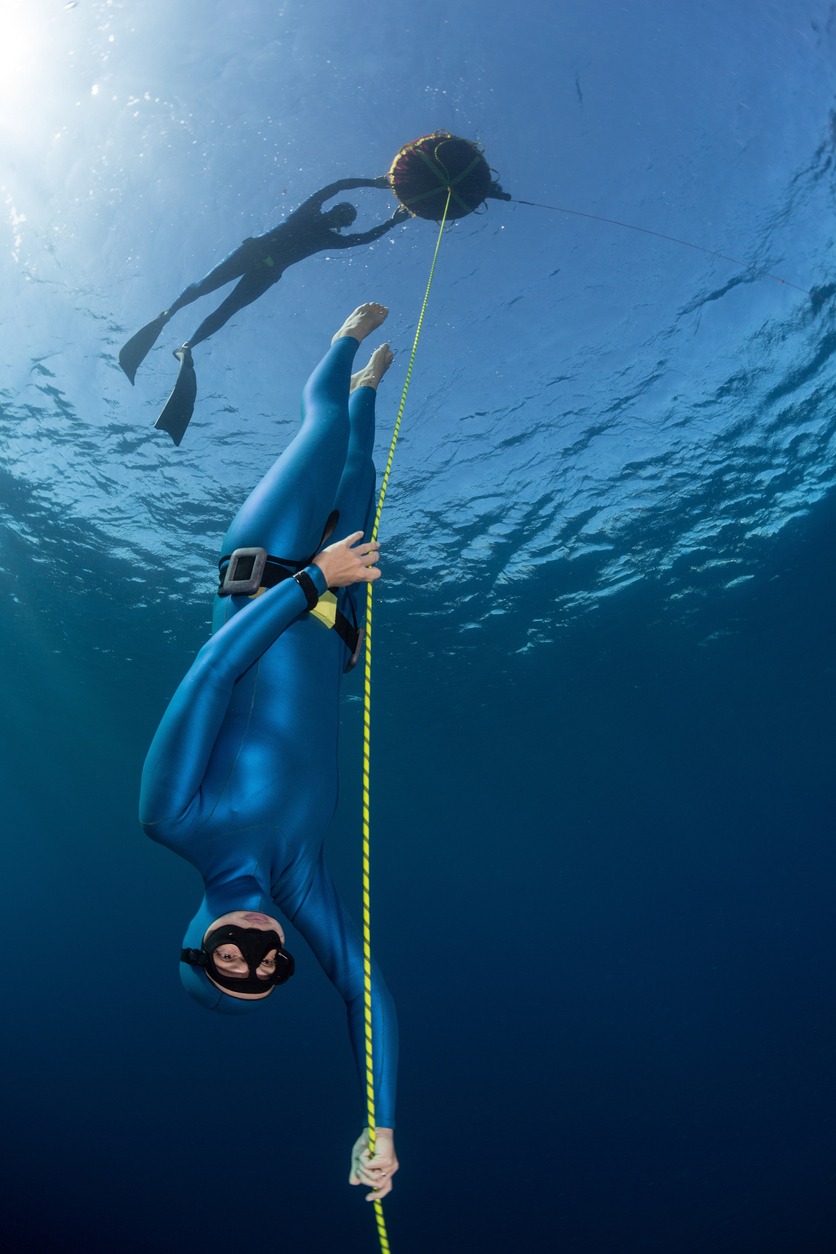Freediving is one way for some people to experience the ocean’s depths without having to wear bulky, awkward, and painful scuba gear. Freediving, in contrast to most other extreme sports that require intense adrenaline pumping, is perceived by some as an extreme sport with the unique quality of demanding deep relaxation and calm. Freediving is viewed by some as a tool for subaquatic hunting. Freediving is viewed by many as a form of self-expression and art, and by many others as a means of achieving oneness with the natural world and the ocean.
Apnea
The Greek term “a-pnoia” (meaning “without breathing”) is where the word “apnea” originates. Even while the word apnea doesn’t actually mean anything aquatic when taken literally, it is now used to describe the activity of freediving, which involves submersion without the use of a respirator.
The Benefits of Apnea
Whatever motivates a person to practice apnea (freediving), it is a sort of deep meditation that improves one’s awareness of oneself and his environment as well as their capacity to focus. Those who practice freediving have greater physical and mental health.
Freediver
Any person who holds his breath while submerged in water is considered a freediver. This includes people who play with fish at a depth of two meters and those who use a sled to descend to a depth of 200 meters.
Equipment for Freediving
Knowing the various pieces of equipment being used and how to use them correctly is crucial for comfort while freediving.
Snorkel
A hollow tube known as a snorkel is often constructed of silicon, rubber, or plastic. You can breathe normally even with your face submerged in water thanks to how it functions as an extension of your respiratory system. The lower, black portion of the mouthpiece is placed in the mouth; the top, red portion is left out of the water. The tube itself is firmly fastened to the mask strap.
For freediving, a snorkel made of rubber or extremely flexible silicone is advised; it can be folded up and carried in the palm of your hand, which lessens drag when swimming underwater. Sometimes, water will get within the tube. When this happens, one should firmly exhale through their mouth to expel the water out and clean the tube.
Freediving Mask
By putting an air cushion between the diver’s eyes and the water, the mask helps the freediver see well in his or her underwater environment. To compensate for the air space during the dive, a freediving mask needs to incorporate a nose pocket. For freediving, a low capacity mask is advised because it requires less air to fill the empty space. A low volume mask can be distinguished from other masks by how far the nose pocket’s edge is from the lenses. The lower the volume, the farther the nose pocket’s edge is from the lenses. When water gets inside the mask, one should place both of his index fingers on the tops of the lens frames and aggressively exhale while looking up. This will get the water out of the mask without taking it off.
Freediving Fins
The freedivers’ legs function as extensions of the fins while freediving. To move water more effectively, freediving fins are often much longer and stiffer than swimming and scuba diving fins. Plastic, glass fiber, or carbon fiber are the materials used to make freediving fins. It is normal for the leg muscles to cramp when first using long bi-fins because of the effort required to move with them. To relieve cramps in the lower leg muscles, grab the fin’s edge and pull it towards the torso, and to relieve cramps in the thigh muscles, grab the fin’s edge and pull it backwards towards the back.
The Weight Belt
The weights required to balance out the wetsuit’s positive buoyancy are carried on the weight belt. Weights should be adjusted so that the freediver is neutrally buoyant at a depth of -10 meters. The optimal material for a freediving weight belt is rubber. When freediving, nylon weight belts, which are frequently used in scuba diving, have a tendency to swirl and move, which can cause loss of focus and control. Rubber weight belts are secured to the body firmly and do not budge as you drop. In order to breathe more comfortably, the weight belt is worn around the waist rather than the stomach like in scuba diving.
The Wet Suit
The freediver’s wetsuit acts as a second skin, keeping the body warm underwater. The ideal freediving wetsuit consists of long pants and a jacket with a beaver tail and hood made of open cell material (which clings to the skin and restricts water circulation between the skin and the suit) (no zippers). Water circulates pretty freely in scuba suits, which is excellent if your body is continuously moving about, generating heat that keeps the water warm. However, scuba suits are not designed for freediving. A better insulation is required since freedivers want to move as little as possible in between dives. The majority of open cell suit manufacturers provide custom suits; these come highly recommended because they fit best.
The Dive Socks
The dive socks reduce the gap between the freedivers’ feet and the (often very uncomfortable) rubber foot pockets of the bi-fin. By keeping the feet warm, the dive sock also avoids cramps in the feet. It is well known that socks slightly reduce the amount of energy that is transferred from the legs to the fins. However, as most freedivers wear socks with bi-fins, this is not a significant loss. The optimal material for freediving socks is open cell neoprene because it adheres to the skin and restricts water flow, keeping the foot warmer for a longer amount of time without requiring the foot to move to generate heat.
Gloves
Different thicknesses of gloves are available, and they are excellent for shielding your hands from the elements, sunburn, and marine life. The ideal glove should be as thin as feasible while still being thick enough to keep your hands warm in cold water and allow you to equalize and handle other equipment.
Lanyard
Freediving lanyards are required for competitions and recommended for the majority of recreational depth training dives. Even on relatively shallow dives, a lanyard should be used if the visibility is poor or the natural bottom is deeper than the line’s bottom. The diver is attached to the line via the lanyard, allowing the diver to be pulled up with the line in case of an emergency.
In case of entanglement, most lanyards contain a one-handed quick-release mechanism. They can also be quickly removed using a non-locking carabiner that connects to the freediving line. Typically, lanyards are no longer than one meter. They can be created at home or purchased from specialized producers.
Dive Computer
A freediving computer is a specialized diving watch that serves numerous purposes, from safety to aiding in training. Some dive computers for scuba divers also feature freediving modes. A dive computer is essential for monitoring depth, timing surface intervals, figuring out dive time and speed, and having a freefall alert.
A dive computer might not be an essential purchase when learning to freedive, but as you develop and begin adding freefall into your dives, its importance for safety, standardizing and enhancing dives, and tracking your progress increases.
Buoy and line
You will need a line for depth freediving, which can be hung from a platform, a buoy, or the side of a boat. It is advisable to have a buoy even if you are freediving for fun so that you may store drinking water, have a place to sit down, and boost your visibility to other boaters.
Safety for Freediving
As we frequently stress our bodies while holding our breath, safety in freediving is of the utmost importance. Therefore, “Never Freedrive Alone” is the most important rule to always keep in mind.
Without a certified companion by your side at all times, one who is trained and prepared to save you in any situation, you should never freedive. Make sure you have a dive plan, a risk assessment, an emergency plan, and that you have informed others of your intended dive location.
To dive safely, you must always make sure that your buoyancy and safety gear are appropriate for the diving environment. If you are diving past your point of neutral buoyancy, the natural bottom is deeper than your buddy can safely pull you from without any training, there is any current, or you can’t always see the diver, you must dive with a line and lanyard that is either attached to a boat or a sizable freediving buoy.
While freediving, you cannot predict what can happen to your body or the environment, therefore you must always dive with every safety precaution in place. No matter how skilled a freediver you are, freak accidents can and do happen. If you don’t follow the simplest safety precautions, you can’t guarantee your personal safety.
Conclusion
In the end, your precious and lovely existence is more essential than any deeper dive, better photo, or fish. It is your obligation to make sure that every dive you take is as safe as it can possible be. Done properly, freediving is a very safe and pleasant activity.



